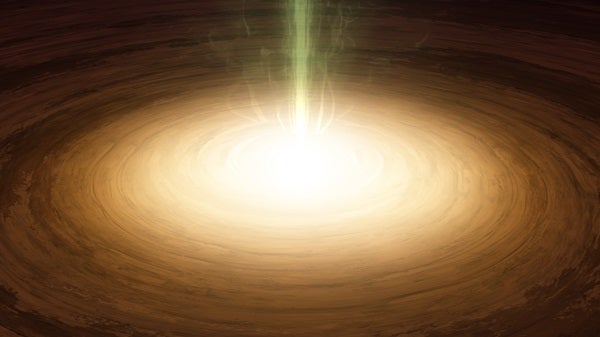Get Swole
Astronomers have a pretty solid understanding of star formation and evolution: a cold, dense cloud of dust and gas collapses under its own gravity and condenses into a hot ball of matter. The remaining dust and gas form a swirling disk around the infant star, from which it slowly but continually steals material from. Previous observations, though, show that the rate stars steal from their disks is too slow to result in their final, enormous masses.
Luckily, one classification of stars could help explain how they gain their mysterious, unaccounted mass. Called FU Ori’s or FUors after the first star of the type discovered, FU Orionis, this class represents stars that are only a few million years old and are surrounded by thick disks of dust and gas. As these disks grow, they become so massive that they lose gravitational stability, and end up dumping their heavy, dusty loads onto their host stars. It’s believed that all stars undergo 10 to 20 of these “FU Ori events” in their early years, but since they’re still hidden behind the molecular clouds that they formed in, they can be difficult to detect.
Tracking Trio
But thanks to data from three high-tech instruments, a team led by California Institute of Technology (Caltech) astronomers was able to capture one of these rare events. The discovery started when ESA’s Gaia mission, which is tasked with mapping a billion nearby stars, spotted a star that was increasing in brightness. Intrigued, the team followed up and found that NASA’s NEOWISE satellite, which scans the skies for asteroids and comets, and their Spitzer Space Telescope witnessed the event, too.
Capable to detecting infrared wavelengths, data from both NEOWISE and Spitzer showed that dust and gas in the star’s disk started to build up and become hotter, causing it to emit beams of infrared light. It’s believed that part of the disk grew so dense that it collapsed under its own gravity and fell toward its host star, dubbed Gaia 17bpi. And when it did, the matter grew hot enough to emit the influx of visible light detected by Gaia.
“These FU Ori events are extremely important in our current understanding of the process of star formation but have remained almost mythical because they have been so difficult to observe,” said Lynne Hillenbrand, a Caltech astronomy professor and lead author of the paper, in a media release. “This is actually the first time we’ve ever seen one of these events as it happens in both optical and infrared light, and these data have let us map the movement of material through the disk and onto the star.”
Added to the list of just 25 FU Ori’s ever detected, Gaia 17bpi’s sudden growth spurt could further solidify this stellar evolution theory, and help solve the mystery of massive stars once and for all.










